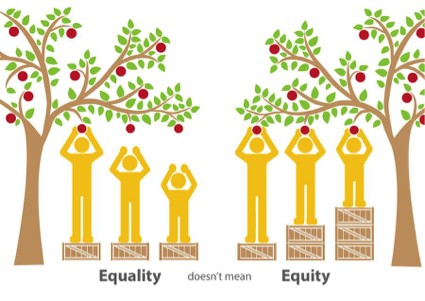
Recently I have been reading articles like “What Are Multi-Tiered System of Supports” and “Response to Intervention 2.0: Next Generation.” Some of these resources help teachers navigate support within specific curricula, while others look at the big picture of RtI and MTSS.
As I read, I can’t help but connect to how my understanding has evolved over the years. This blog post describes a bit about how I began to see that the old educational saying “Equality does not equal equity” with a new lens. I have come to realize that my teaching is about finding the right mix between allowing productive struggle for students and layering in a support.
In 2009, I was asked to teach second grade. That year, like every other year, I had a wide range of learners in my classroom. One student was unhappy about repeating second grade; several students had identified, formal accommodations; many students without identified learning differences needed accommodations to access the learning; one student’s mom was battling terminal cancer; and another students’ dad was barred from our school campus for safety reasons. Each individual was on his or her own journey. Each day, our paths would come together at 8:00 AM and separate at 2:30 PM. During the six and half hours we were together, I did my best to meet the needs of each one of my 18 students.
That year, I was hesitant to implement the Response to Intervention (RtI) that the school was piloting. I knew my students “like the back of my hand,” and I worried that the RtI system made my teaching inauthentic. Putting my instruction or my students into a “check off the box system” was the last thing I would do as a teacher because I-not some new state system-knew what was best for them. I thought the system went against what I had been trained to do as a teacher, differentiate instruction for all of my learners, all the time. It was my responsibility to help students not to struggle. In fact, struggling meant that I was not meeting their needs, and I needed to modify my instruction right away. My job was to help each one of my students reach their potential, and the RtI system was making me wait to provide support. Why in the world would I ever wait to help a kid? I thought RtI asked me to wait for a student to fail before I had the “green light” to provide support. This is not the way I wanted to operate as a teacher.
After eight years working with RtI, I now understand it in a completely different way. The system gives me a framework for tackling the tricky task of discerning if students are truly learning and what can be done to support their growth. The tiered system supports me and other teachers in solving problems in that difficult space between where a student is and where a student could be. Often, teachers spend the majority of their time alone, with no time to step back and see the big picture. Are students learning? If they are, why are they learning? If they’re not, what are things that I could do? The three tiers within RtI provide me with the tools to be able to step back, look at the big picture, and make decisions about how to help students collaboratively with my fellow educators.
The Power of Tier 1
One of the biggest lessons I’ve learned is the power of Tier 1 instruction. Inclusivity is at the heart of RtI. Regardless of who you are, what your parents do for a living, what score you have on that state standardized test, or what learning difference you may have, within an RtI model all students receive the same Tier 1 instruction.
This concept seems simple, but it’s not something that I was doing consistently in my classroom. I thought that I was helping my students who were struggling by raising my level of scaffolding so high that these students weren’t receiving Tier 1 instruction. Once I really began wrapping my head around RtI, I realized that I was depriving some students from the main dish, which was core instruction. I was unconsciously providing a completely different Tier 1 for students who struggle-sending the message that I didn’t think certain students could handle some parts of the lesson. I was doing this with the purest of intentions and in the spirit of knowing what’s best for my students, but in actuality, I was preemptively making instructional decisions for some students and putting intervention in place without giving those students a chance to be in their least restrictive environment.
I wasn’t stepping back to see how a student responded to intervention because I was just layering on intervention. It’s almost as if I didn’t distinguish between Tier 1 and intervention. Once I lowered my scaffolding for specific students, I saw that they actually didn’t need every single support I was providing. Students were capable of being more independent than I was allowing them to be. I started observing students in a different way. If I did layer on a support, I gave that support time to work. I carefully watched students in Tier 1 to see how they would respond to their support and then make my instructional decision.
Once I truly embraced the idea that every single one of my students should have access to Tier 1 instruction, I began working to enhance this experience. As I did this, Tier 1 became more inclusive and every student could be a part of the learning, no matter what learning difference existed.
Check out Ashley’s previous blog here!
